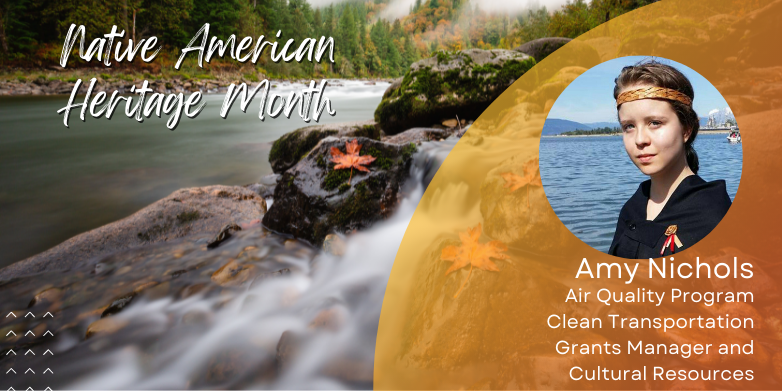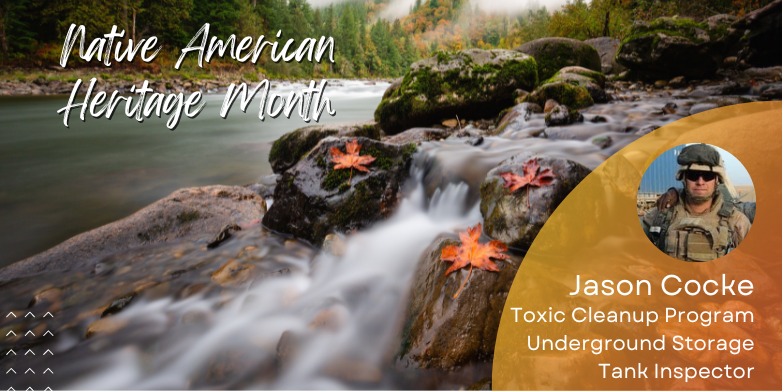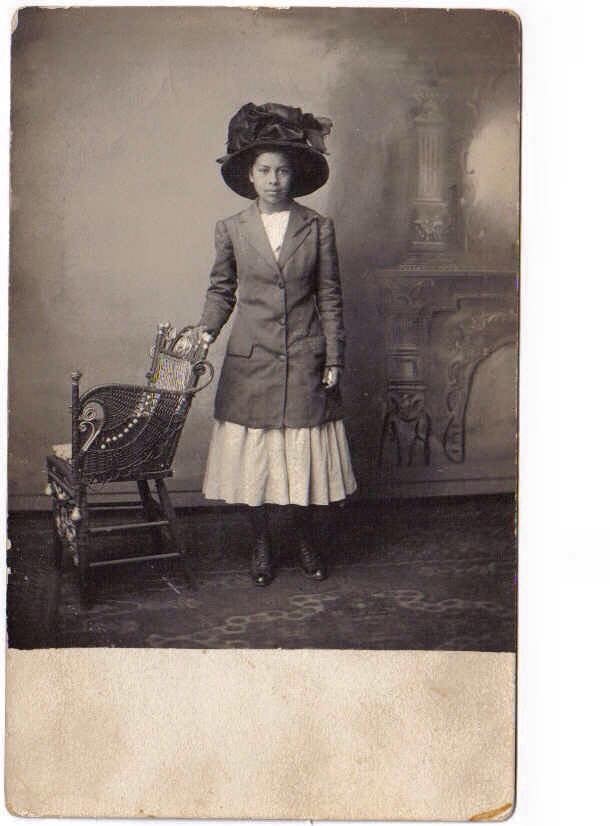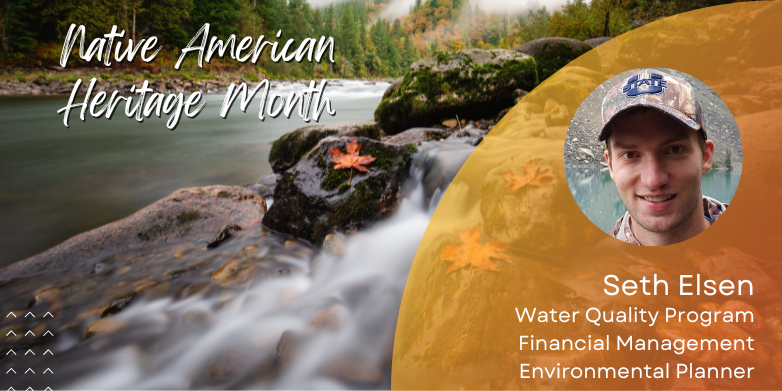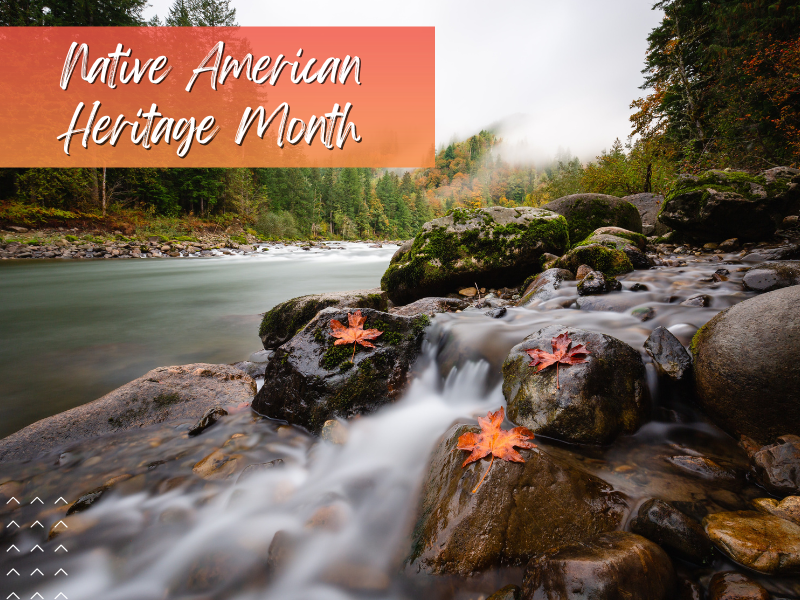
Sharing stories about our work and the people who carry it out builds connections within our agency and the communities we serve.
When we launched our Women in Science blog, Asian American Native Hawaiian Pacific Islander blog, and Hispanic Heritage Month series, we heard from many people within the agency and outside the agency that they really enjoyed learning about the people who work at Ecology and their work. People asked us to continue these efforts, so we are.
We hope you enjoy our Native American Heritage Month blog series and the stories our staff share.
Nów7 Si7am,
In the language of my ancestors, the Samish people, “Hello honorable friends and relatives.”
November is Native American Heritage month, and Native American Heritage Day is recognized the day after Thanksgiving. It was this month, in November of 1999, that leaders of American Indian Nations and the State of Washington wrote, and committed to follow, the Centennial Accord, Millenial Agreement. As an Ecology employee these principles should guide our work with Tribes. The agreements outline our government-to-government relationship with federally recognized Indian tribes as a state government, including our commitments to:
- Strengthen our government-to-government relationships, working to understand Tribes' legal and political status as governments.
- Cooperate into the future through long-lasting communication and government-to-government processes that quickly and effectively resolve issues of mutual concern.
- Develop and maintain a consultation process, protocols and action plans that follow the Centennial Accord's promise that "The parties will continue to strive for complete institutionalization of the government-to-government relationship by seeking an accord among all the tribes and all elements of state government."
- Educate the state about tribal history, culture, treaty rights, contemporary Tribal and state government institutions and relations and the contribution of Indian Nations to the State of Washington.
- Collaborate to gain mutual understanding and respect and to fight discrimination and racial prejudice.
- Coordinate and cooperate as we improve economic and infrastructure opportunities, protect natural resources, and provide the educational opportunities and social and community services that meet the needs of all our citizens.
These principles form part of racial equity and justice at Ecology. As a state agency, we have a government-to-government commitment to honoring the reserved rights and the agreements we have with the Indigenous peoples of the state. The Centennial Accord promises "‘The parties recognize that implementation of this Accord will require a comprehensive educational effort to promote understanding of the government-to-government relationship within their own governmental organizations and with the public.’” Internally, Ecology’s government-to-government training focuses on the history of Native Americans in Washington State and teaches how to improve work relationships with our Tribal government counterparts. Working for the state, we must follow agreements with Tribes, including educating ourselves about Native American cultures today. We have committed to working together now and in the future.
This month, I hope that you take time to honor the land and the people who have called it home since time immemorial. In the state of Washington, there are 29 federally recognized Tribes, three state recognized tribes, and many more people of Indigenous heritage. Native Americans lived here, live here, and will continue to live here. Honoring the treaties and the accords is essential to our relationships with the diverse Native American cultures and communities across the state.
Learning Resources:
- Young and Indigenous [YAI] Podcast from Children of the Setting Sun Productions
- Native American Heritage Day by Native Hope
- Mid-Atlantic Equity Consortium (MAEC) list of resources, events, books, and more to learn and celebrate Indigenous heritage
- Native American Heritage Collection by PBS
- Learning resources and easy to share social media posts about Indigenous Heritage Month
- 6 Misconceptions About Native American People | Teen Vogue – YouTube
Hóy7sxwq’e (“thank you” in the Samish Language),
Amy Nichols (she/her) | Barrett Family, Samish Nation | Air Quality, Climate Policy Section
Jason Cocke
I am a tribal member of the Choctaw Tribe of Oklahoma
Lilly Bell Kelly, Choctaw Tribe, circa 1890 - 1900.
I don’t know much about my great grandmother, Lilly Bell Kelly, other than she was a full Choctaw. The picture I provided dates around the late 1890s. We never really discussed our native heritage growing up.
My mother was able to secure our Certificate of Degree of Indian Blood cards and tribal membership after I graduated high school. All I know is that Lilly Bell Kelly is beautiful, and I am proud to be her descendent.
I remember growing up down south and always being out in the woods, especially playing in the creeks. We called it “creeking”. We would spend days catching water moccasins, copperhead snakes, and fish for catfish. Snakes were just fun to catch and the catfish we would take home to eat. I loved being in nature and always felt at home there.
Today, I work for our Eastern Region Office as an underground storage tank inspector which is a crucial part of protecting the groundwaters of our state.
“ I loved being in nature and always felt at home there.”
Most regulated underground tanks store petroleum, whether it be diesel or gasoline. Many industries have underground storage tanks and most people are very surprised that it’s not just the gas station on the corner. There are many municipalities and private industries that you would not know that store regulated materials underground. I work with many dams, data centers, military bases, feed lots, and other random industries. Tanks are out there.
Protecting our natural resources
My life has been shaped by partnering with the regulated community in protecting our natural resources. I’ve worked in the environmental industry for most of my life and have the upmost respect for it — trying to leave no mark and preserve what it is. It’s important to have that preservation for future generations to enjoy.
Being part of a team that strives to protect all of our natural resources was a goal that came true for me 18 years ago when I joined Ecology. My part is to protect groundwater from contaminants that may leak from underground storage tanks. I work hard to help the regulated community understand the importance of protecting the waters of our state, especially when they are unaware of potential consequences that can harm our environment. Education is key.
“I really enjoy working with our community partners.”
I like working with the public and being a positive face of our agency. Ensuring regulatory requirements are met is meaningful to me. I really enjoy working with our community partners to reach the end goal of protecting our groundwater.
I partner with the single-site owner of gas stations all the way up to major sites such as the Microsoft Corporation. I am able to wear a different hat and work with each site accordingly, so they all get the same respect and service from me regardless of size. It’s important to me that I put myself in their shoes and try to understand where they are when working with Ecology.
Seth Elsen
Tell us about your Native American heritage and how it shapes your life and work.
I’m an enrolled member of the Brothertown Indian Nation (Wisconsin), and descendent of the Mohegan Tribe. I often travel back to Wisconsin, serving on my Tribe’s council and leading our own environmental protection initiatives. My heritage shapes my life and work in many different ways. I try to do everything in a way that would make my ancestors proud. I try to look at things in a more holistic way, especially when it comes to natural resources.
It’s important to blend western science with traditional knowledge. Indigenous communities have been on the front lines of natural resource management since time immemorial, and that knowledge is crucial in understanding resource management. Professionally, I practice this in my role managing projects, and also carrying out our agency’s responsibility for protecting archaeological sites and sacred places.
What do you do at Ecology?
I work as an environmental planner in the Water Quality Program’s Financial Management Section. I am part of a team that carries out cultural resource protection work for our funded projects, and I am involved in managing on-site sewage system and non-point source projects throughout the state.
My work provides me the opportunity to work in partnership with more than 30 sovereign nations throughout Washington, Idaho, and Oregon while ensuring long-term water quality protection and increasing community resilience.
Share a recent project you worked on or a project that was especially meaningful to you.
I love any opportunity to get to work with stakeholders. Over the last year, I’ve been working with Tribes, land trusts, and local governments to develop a flexible and fast funding approach to support high-priority land acquisition. This work would help to address water quality impairments, protect drinking water, and restore habitat vital to salmon.
What gets you excited to go to work each day or what advice do you have for someone interested in working at a natural resource agency?
Getting to work closely with Tribes and communities on water quality protection and restoration in a way that promotes salmon recovery, treaty rights, and cultural identity makes every day at Ecology exciting.


